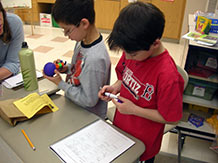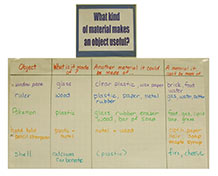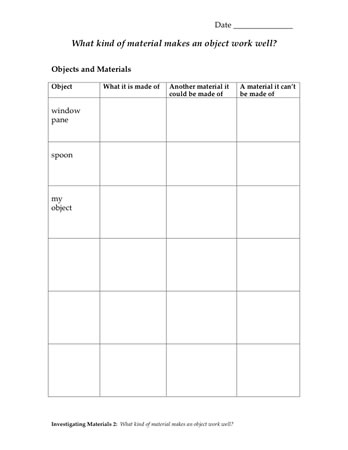What kind of material makes an object work well?
Plan Investigating Materials 2
Feather dusters … rubber duckies … wooden boats … a tin raincoat. One of these objects doesn’t sound very sensible. Why not?
In this lesson, students think about materials in terms of their usefulness to objects and the way those objects function. First they will consider what materials are appropriate for certain objects. Then they will brainstorm some materials that would be wildly wrong.
Together you will compile a table of objects and materials that function very well and very badly.
By the end of the investigation, students will have more experience distinguishing objects and the materials they are made of and have begun thinking about the properties of different materials, which is the subject of the next investigation.
Learning Goals
- to think about what materials make an object work well
- to learn to write a scientific reflection
| Sequence of experiences | ||
|---|---|---|
| 1. Ask the question | All Class | 15 Mins |
| 2. Consider some materials | Small Groups | 15 Mins |
| 3. Make meaning | All Class | 10 Mins |
| 4. Write a reflection | Individual | 5 Mins |
Materials and Preparation
For the class:- Post the investigation question in a place where all students can see it.
- Make a table for class discussion on a whiteboard or flip chart, setting out lines for 7 objects; an example can be found in Step 1.
- 1 plastic spoon for class discussion
- 1 personal object selected by student
1. Ask the question
Students have been thinking about objects and the materials they are made of. Today’s question:
Some materials are better than others for a particular object; in fact some objects won’t work at all if they are made of the wrong materials. Provide an example:
- What are windowpanes usually made of?
(Glass, and possibly plastic) - What is it about glass and plastic that makes them good materials for windowpanes?
(Light can pass through them but they block the wind. They are transparent materials.) - Why not use wood for windowpanes? Wood is stronger and will not break as easily.
(Light can’t pass through wood.)
Have some fun with this discussion by encouraging some outlandish examples — e.g., a spoon can’t be made of butter because it would melt or get eaten. This will encourage flexible thinking and introduce a wider range of material properties, which will be useful in the next lesson.
To make a useful object, you have to choose your materials carefully. Today students will investigate some objects and think about what materials work well for them. They will also think about materials that would not work well for those objects.
Complete the first row of the classroom table using the windowpane example. Next hold up a plastic spoon and ask the students what to record in the table. Use the terms row and column as you refer to places in the table.
| Object | What it is made of | Other materials that might work well | Materials that would work badly |
|---|---|---|---|
| Window pane | Glass | Plastic | Wood |
| Spoon | Plastic | Metal, wood | Butter |
| (Student use) | |||
| (Student use) | |||
| (Student use) | |||
| (Student use) | |||
| (Student use) |
2. Choose and describe an object

Allow time for students to record the information about the windowpane and the spoon.
Students retrieve their personal or classroom object. They should record information for their object and at least one other object from their workgroup.
The following data is recorded in the table:
- the first column lists the name of the object.
- the second column lists the materials the object is made of.
- the third column lists any other materials that would allow the object to work well
- the fourth column lists materials that would be wrong for the object
Encourage students to share their entries with each other. Listen to how they are talking about materials, paying particular attention to whether they are distinguishing between objects and materials. Also, check to see if the students can organize information in the columns and rows of their table.
Ask a few (2–4) students with different objects to add their information to the class table.
Detours: Some students may become distracted by materials that appear in an object but are not obviously related to its usefulness or function. Glitter is an example. You can refocus attention on the primary material of manufacture, but you might also point out that the extraneous materials are also “useful” — e.g., for capturing a child’s attention or making the object “pretty.”
3. Make meaning
Review the class table in light of the investigation question:

This teacher has used different colored markers to clearly delineate the different rows of the table, giving a visual cue to understand the way the data is organized.
Purpose of the discussion
The purpose of the discussion is to heighten students’ awareness of relationships between a material, its properties, and an object’s function.
Engage students in the focus question
Based on the information in our class table, what kinds of materials make an object work well?
Use the data from class table.
Ask students to provide a rationale for their ideas.
- The material used in [object] is [what it is made of]. Does anyone else have an object that uses this material?
- Do you think that this [other object] could also be made of [the alternative material] Why do you think that?
- Do you agree your [other object] would not work well if it were made of [the inappropriate material] Why do you think that?
Have students defend their claims about alternative or inappropriate materials.
For example,
- “Yes, that material would also work in this object because it’s hard [or it’s strong, or it’s slippery].”
- “No, that material will not work in this object because it’s shiny [or it’s too heavy or it’s the wrong color].”
What would you say to a person who asks, “What kinds of materials make an object work well?”
Listen for responses that indicate students recognize that the choice of material will depend on the function of the object and the properties of the material.
Continue with this discussion, moving through the 5 objects students added to the classroom list. The purpose of this exercise is to heighten students’ awareness of relationships between a material, its properties, and an object’s function.
4. Write a reflection
Letter from the Engineer
You may know something about the work that scientists do. Some study the stars and planets. Some study the different plants and animals on Earth. Some study the non-living parts of Earth, such as the rocks, ice, and oceans. All scientists study the natural world to learn more about how it works. They notice changes and they try to understand why the changes are happening. They ask questions, and they often work with other scientists to try to find the answers. For example, scientists might ask, “Why did the birds that use to come here every summer stop coming? What happened? What is different now?” Scientists can spend years trying to answer their own questions. They make careful observations, they take notes, and they work to make sense of the information or data they have collected.
Scientists sometimes work with engineers, but the main job of an engineer is different than the scientist’s. The main job of an engineer is to solve problems, usually to provide people with something they need or want. Engineers also ask themselves questions, but their questions are about the problems they solve. They ask, “How can we build a car that uses less gasoline?” or “How can we build a robot that will help scientists explore Mars?” Engineers also study the materials that are used to make objects. They might ask, “Will this object work better if it is made from plastic or made from wood?” or “How can we make this glass stronger, so if something hits it, it will not break?”
In your investigations you will be thinking like a scientist most of the time, but there will also be times when you will need to think like an engineer, and solve problems that will then help you to learn more about the natural world.
Look for more Letters from the Engineer. These will point out some of the times when thinking like an engineer is important.
Introduce the word reflection and explain that it means thinking seriously about something you have recently learned.
Language note: Comparing reflections: Just as your reflection looks back at you from the mirror, you can look back on the day’s lesson, bringing up ideas and questions about what you have learned.
Remind students of today’s question: What kind of material makes an object useful? Students should work on the Reflection in their notebooks to complete the sentence starters:
- Something interesting I learned about objects and materials is …
- A question I have about objects and materials is …
- I wonder
You may wish to use this time to record your own reflections about how your students are currently understanding objects and materials.







